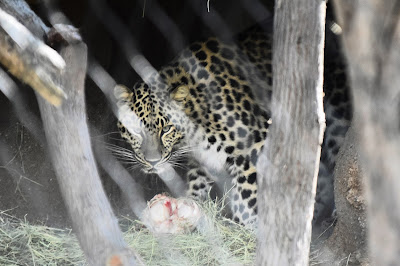Taking advantage of our yearly pass, we returned on Wednesday to the San Diego Zoo. Since it was winter, the park was much less crowded with all the children back in school. Our first stop was the Outback section where we saw Tasmanian Devils, Kookaburras and the napping Koala Bears from Australia. In the Urban Jungle, we talked to the docent about the Giraffes, watching a mother feeding with her child before she moved over to the pool for a drink. It was very cool to watch as she splayed out her forelegs so her head could reach, spraying the water out in long arcs as she raised her long neck back up to its great height. I have seen this behavior on nature videos but never in real life. Nearby in the center enclosure, we watched a Rhinoceros being fed, using its prehensile lip to eagerly grab the treats from the keeper's hand. This area used to be the Elephant Mesa with elephant rides when I was a child where I had a chance to ride on their broad swaying backs.
As we approached the troop of Hamadryas Baboons in the Ethiopian Highlands exhibit, we witnessed a battle royal. We saw a female baboon chasing after a male who responded by trying to mate with her. This pissed off another male and the two proceeded to fight, drawing the rest of the males into a screaming rumble as they fought and chased each other around the rocky enclosure. We saw the anxious keepers keeping a close watch over them until they calmed down about 5 minutes later. We learned afterward that the male baboon patriarch had recently died which upset the troop hierarchy and the remaining males where still working out the new power dynamic. In the nearby enclosure, the Geladas must have been riled up by all the hooting and hollering from the Baboons as they began running around their exhibit as well, shaking the trees and screeching at each other with bared teeth. Even though a nickname for the Gelada is Bleeding Heart Baboon, they are in a different Genus from their Baboon relatives.
Leaving the two primate species behind, we wandered the winding trail through the Africa Rocks area where we watched a Leopard feeding on a animal leg and Lemurs from Madagascar climbing the netting of their enclosure. We went through three different aviaries as we climbed the slope of the canyon. The first was filled with birds from Africa like the Taveta Golden Weaver building a nest over our heads and the Exclamatory Paradise-Wydah with long tail feathers that were three times the length of its body. The Parker Aviary were filled with tropical birds from South America like the Toucan and the Andean cock-of-the-rock, the national bird of Peru with it's distinctive disk-shaped plumage of orange feathers on its head.
After the aviaries, we walked down the Orangutan Trail to visit the enclosure that the hairy red apes from Indonesia and Borneo share with the Siamang Gibbons. With the two mothers sitting nearby, we watched the two youngest members of the different species wrestle and cuddle on the ground. Sela, the three year old gibbon, loved swinging around a thick rope and landing back onto the nine year old Aisha who rolled around on her favorite burlap sack. Sela was born premature, almost half the weight of a normal newborn, but she quickly gained weight to become a healthy juvenile. When we visited the bear exhibits, they were all empty except for the Andean Bear roaming around its enclosure. It is also called the Spectacled Bear due to the white patterns of fur around its face that resemble glasses. This is the same species as Paddington Bear from the children's books who came to England from the Andean mountains in Darkest Peru.
It was a sunny day as we rode the Skyfari aerial tram back across the park to visit the Elephant Odyssey. One of the elephants was playing with the interactive feeding structures while another was using her trunk to give herself a dust bath. In the wild, elephants use this behavior to protect their skin from the sun and repel bugs. We also saw two huge California Condors perched high up in their exhibit before we headed to the Reptile Walk for the last part of our visit. By the shape of their shells, we could identify which of the islands the Galapagos Giant Tortoises originated. By the time we had finished checking out Komodo Dragons in their separate exhibit, we had walked over 5 miles. On the way home, we stopped at El Tianguis for their rolled taquitos, the best in the city!

















No comments:
Post a Comment